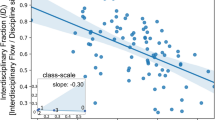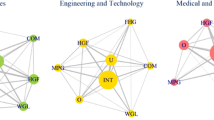Abstract
Knowledge communication plays a fundamental role in studies of science of science. This paper aims to examine inter-specialty communication patterns within a discipline using author citation networks. Two metrics are designed, including average knowledge flow and average shortest distance. They are used to identify the impact and diffusion characteristics of inter-specialty knowledge communication. We apply these metrics to an empirical data set of Chinese library and information science (CLIS) publications. We find that the two metrics portray different aspects of knowledge communication in CLIS and conclude that indirect paths, the size of specialties, and the communication structure among specialties may lead to the differences.








Similar content being viewed by others
References
Agrawal, A., & Henderson, R. (2002). Putting patents in context: Exploring knowledge transfer from MIT. Management Science, 48(1), 44–60.
Blondel, V. D., Guillaume, J.-L., Lambiotte, R., & Lefebvre, E. (2008). Fast unfolding of communities in large networks. Journal of Statistical Mechanics: Theory and Experiment, 2008(10), P10008.
Borgman, C. L., & Furner, J. (2002). Scholarly communication and bibliometrics. In B. Cronin (Ed.), Annual review of information science and technology (Vol. 36, pp. 3–72)., Information Today NJ: Medford.
Bornmann, L., & Leydesdorff, L. (2015). Topical connections between the institutions within an organisation (institutional co-authorships, direct citation links and co-citations). Scientometrics, 102(1), 455–463.
Chen, C., & Morris, S. (2003). Visualizing evolving networks: Minimum spanning trees versus pathfinder networks. In Information Visualization, 2003. INFOVIS 2003. IEEE Symposium on (pp. 67–74): IEEE.
De Nooy, W., Mrvar, A., & Batagelj, V. (2005). Exploratory social network analysis with Pajek. New York: Cambridge University Press.
Dijkstra, E. W. (1959). A note on two problems in connexion with graphs. Numerische Mathematik, 1, 269–271.
Garvey, W. D., & Griffith, B. C. (1971). Scientific communication: Its role in the conduct of research and creation of knowledge. American Psychologist, 26(4), 349.
Jaffe, A. B., & Trajtenberg, M. (1998). International knowledge flows: Evidence from patent citation. Papers, 8(1), 105–136.
Jaffe, A. B., Trajtenberg, M., & Fogarty, M. S. (2000). Knowledge spillovers and patent citations: Evidence from a survey of inventors. American Economic Review, 90(2), 215–218.
Jaffe, A. B., Trajtenberg, M., & Henderson, A. D. (1993). Geographical localization of knowledge spillovers by patent citations. Quarterly Journal of Economics, 108(3), 577–599.
Lambiotte, R., & Panzarasa, P. (2009). Communities, knowledge creation, and information diffusion. Journal of Informetrics, 3(3), 180–190.
Leicht, E. A., & Newman, M. E. (2008). Community structure in directed networks. Physical Review Letters, 100(11), 118703.
Leydesdorff, L. (2004). Top-down decomposition of the journal citation reportof the social science citation index: Graph-and factor-analytical approaches. Scientometrics, 60(2), 159–180.
Leydesdorff, L. (2006). Can scientific journals be classified in terms of aggregated journal–journal citation relations using the Journal Citation Reports? Journal of the American Society for Information Science and Technology, 57(5), 601–613.
Leydesdorff, L., & Jin, B. (2005). Mapping the Chinese Science Citation Database in terms of aggregated journal–journal citation relations. Journal of the American Society for Information Science and Technology, 56(14), 1469–1479.
Leydesdorff, L., & Probst, C. (2009). The delineation of an interdisciplinary specialty in terms of a journal set: The case of communication studies. Journal of the American Society for Information Science and Technology, 60(8), 1709–1718.
Leydesdorff, L., & Rafols, I. (2009). A global map of science based on the ISI subject categories. Journal of the American Society for Information Science and Technology, 60(2), 348–362.
Leydesdorff, L., & Rafols, I. (2011). Indicators of the interdisciplinarity of journals: Diversity, centrality, and citations. Journal of Informetrics, 5(1), 87–100.
Lucio-Arias, D., & Leydesdorff, L. (2007). Knowledge emergence in scientific communication: From “fullerenes” to “nanotubes”. Scientometrics, 70(3), 603–632.
Mehta, A., Rysman, M., & Simcoe, T. (2010). Identifying the age profile of patent citations. Social Science Research Network, 25(7), 1179–1204.
Mingers, J., & Leydesdorff, L. (2015). Identifying research fields within business and management: A journal cross-citation analysis. Journal of the Operational Research Society, 66(8), 1370–1384.
Nomaler, Ö., & Verspagen, B. (2008). Knowledge flows, patent citations and the impact of science on technology. Economic Systems Research, 20(4), 339–366.
Persson, O. (2001). All author citations versus first author citations. Scientometrics, 50(2), 339–344.
Persson, O. (2010). Identifying research themes with weighted direct citation links. Journal of Informetrics, 4(3), 415–422.
Porter, A., Cohen, A. S., Roessner, J. D., & Perreault, M. (2007). Measuring researcher interdisciplinarity. Scientometrics, 72(1), 117–147.
Porter, A., & Rafols, I. (2009). Is science becoming more interdisciplinary? Measuring and mapping six research fields over time. Scientometrics, 81(3), 719–745.
Rafols, I., & Meyer, M. (2010). Diversity and network coherence as indicators of interdisciplinarity: Case studies in bionanoscience. Scientometrics, 82(2), 263–287.
Ramalho Correia, A. M., & Teixeira, J. C. (2005). Reforming scholarly publishing and knowledge communication: From the advent of the scholarly journal to the challenges of open access. Online Information Review, 29(4), 349–364.
Schneider, J. W., Larsen, B., & Ingwersen, P. (2009). A comparative study of first and all-author co-citation counting, and two different matrix generation approaches applied for author co-citation analyses. Scientometrics, 80(1), 103–130.
Schvaneveldt, R. W. (1990). Pathfinder associative networks: Studies in knowledge organization. New York: Ablex Publishing.
Shibata, N., Kajikawa, Y., Takeda, Y., & Matsushima, K. (2008). Detecting emerging research fronts based on topological measures in citation networks of scientific publications. Technovation, 28(11), 758–775.
Shibata, N., Kajikawa, Y., Takeda, Y., & Matsushima, K. (2009). Comparative study on methods of detecting research fronts using different types of citation. Journal of the American Society for Information Science and Technology, 60(3), 571–580.
Tsay, M.-Y. (2015). Knowledge flow out of the domain of information science: A bibliometric and citation analysis study. Scientometrics, 102(1), 487–502.
Van Leeuwen, T., & Tijssen, R. (2000). Interdisciplinary dynamics of modern science: Analysis of cross-disciplinary citation flows. Research Evaluation, 9(3), 183–187.
Wang, H. Y., Huang, Q., Li, C. T., & Chu, B. Z. (2010). Tulun suanfa jiqi MATLAB shixian [Graph Theory Algorithms Based on MATLAB]. Beijing: Beihang University Press.
White, H. D. (2001). Authors as citers over time. Journal of the American Society for Information Science and Technology, 52(2), 87–108.
White, H. D. (2003). Pathfinder networks and author cocitation analysis: A remapping of paradigmatic information scientists. Journal of the American Society for Information Science and Technology, 54(5), 423–434.
White, H. D., & Griffith, B. C. (1981). Author cocitation: A literature measure of intellectual structure. Journal of the American Society for information Science, 32(3), 163–171.
White, H. D., & McCain, K. W. (1998). Visualizing a discipline: An author co-citation analysis of information science, 1972–1995. Journal of the American Society for information Science, 49(4), 327–355.
Wikgren, M. (2002). Health discussions on the Internet: A study of knowledge communication through citations. Library and Information Science Research, 23(4), 305–317.
Yan, E. (2014). Finding knowledge paths among scientific disciplines. Journal of the Association for Information Science and Technology, 65(11), 2331–2347.
Yan, E. (2015). Disciplinary knowledge production and diffusion in science. Journal of the American Society for Information Science and Technology. doi:10.1002/asi.23541.
Yan, E., Ding, Y., Cronin, B., & Leydesdorff, L. (2013). A bird’s-eye view of scientific trading: Dependency relations among fields of science. Journal of Informetrics, 7(2), 249–264.
Yang, S., & Wang, F. (2015). Visualizing information science: Author direct citation analysis in China and around the world. Journal of Informetrics, 9(1), 208–225.
Yu, W., Chen, G., Cao, M., & Kurths, J. (2010). Second-order consensus for multiagent systems with directed topologies and nonlinear dynamics. Systems, Man, and Cybernetics, Part B: Cybernetics, IEEE Transactions on, 40(3), 881–891.
Zhao, D., & Strotmann, A. (2008). Evolution of research activities and intellectual influences in information science 1996–2005: Introducing author bibliographic-coupling analysis. Journal of the American Society for Information Science and Technology, 59(13), 2070–2086.
Acknowledgments
This work is supported by the National Social Science Foundation of China (No. 12CTQ026), the Program for the Top Young Academic Leaders of Higher Learning Institutions of Shanxi (No. 2014052006) and the 131 Leading Talents Project of Colleges and Universities of Shanxi.
Author information
Authors and Affiliations
Corresponding author
Rights and permissions
About this article
Cite this article
Ma, R., Yan, E. Uncovering inter-specialty knowledge communication using author citation networks. Scientometrics 109, 839–854 (2016). https://doi.org/10.1007/s11192-016-2091-2
Received:
Published:
Issue Date:
DOI: https://doi.org/10.1007/s11192-016-2091-2




